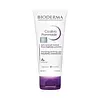What's inside
What's inside
 Key Ingredients
Key Ingredients

 Benefits
Benefits

 Concerns
Concerns

 Ingredients Side-by-side
Ingredients Side-by-side

Water
Skin ConditioningGlycerin
HumectantParaffinum Liquidum
EmollientCaprylic/Capric Triglyceride
MaskingFructooligosaccharides
HumectantPolyglyceryl-4 Diisostearate/Polyhydroxystearate/Sebacate
EmulsifyingPropanediol
SolventXylitol
HumectantZinc Stearate
Cosmetic ColorantSodium Citrate
BufferingButylene Glycol
HumectantCapryloyl Glycine
CleansingCopper Sulfate
Skin ConditioningSodium Hydroxide
BufferingSodium Hyaluronate
HumectantZinc Sulfate
AntimicrobialVitis Vinifera Vine Extract
Skin ConditioningLaureth-3
EmulsifyingAsiaticoside
AntioxidantMadecassic Acid
Skin ConditioningAsiatic Acid
Skin ConditioningLaminaria Ochroleuca Extract
Skin ConditioningHydroxyethylcellulose
Emulsion StabilisingAcetyl Dipeptide-1 Cetyl Ester
Skin ConditioningMannitol
HumectantPotassium Sorbate
PreservativeRhamnose
HumectantWater, Glycerin, Paraffinum Liquidum, Caprylic/Capric Triglyceride, Fructooligosaccharides, Polyglyceryl-4 Diisostearate/Polyhydroxystearate/Sebacate, Propanediol, Xylitol, Zinc Stearate, Sodium Citrate, Butylene Glycol, Capryloyl Glycine, Copper Sulfate, Sodium Hydroxide, Sodium Hyaluronate, Zinc Sulfate, Vitis Vinifera Vine Extract, Laureth-3, Asiaticoside, Madecassic Acid, Asiatic Acid, Laminaria Ochroleuca Extract, Hydroxyethylcellulose, Acetyl Dipeptide-1 Cetyl Ester, Mannitol, Potassium Sorbate, Rhamnose
Water
Skin ConditioningCoco-Caprylate/Caprate
EmollientButyrospermum Parkii Butter
Skin ConditioningSesamum Indicum Seed Oil
EmollientPrunus Amygdalus Dulcis Oil
Skin ConditioningGlycerin
HumectantCetearyl Alcohol
EmollientSucrose Distearate
EmollientGlyceryl Stearate
EmollientPotassium Olivoyl Hydrolyzed Oat Protein
CleansingHexyldecanol
EmollientHexyldecyl Laurate
EmollientTilia Platyphyllos Flower Water
Skin ConditioningBenzyl Alcohol
PerfumingSodium Lactate
BufferingHydroxyethyl Acrylate/Sodium Acryloyldimethyl Taurate Copolymer
Emulsion StabilisingParfum
MaskingGlyceryl Oleate
EmollientXanthan Gum
EmulsifyingDehydroacetic Acid
PreservativePolysorbate 60
EmulsifyingSorbitan Isostearate
EmulsifyingTocopherol
AntioxidantPotassium Sorbate
PreservativeSodium Benzoate
MaskingSodium Hydroxide
BufferingCitric Acid
BufferingLinalool
PerfumingLimonene
PerfumingCitronellol
PerfumingGeraniol
PerfumingWater, Coco-Caprylate/Caprate, Butyrospermum Parkii Butter, Sesamum Indicum Seed Oil, Prunus Amygdalus Dulcis Oil, Glycerin, Cetearyl Alcohol, Sucrose Distearate, Glyceryl Stearate, Potassium Olivoyl Hydrolyzed Oat Protein, Hexyldecanol, Hexyldecyl Laurate, Tilia Platyphyllos Flower Water, Benzyl Alcohol, Sodium Lactate, Hydroxyethyl Acrylate/Sodium Acryloyldimethyl Taurate Copolymer, Parfum, Glyceryl Oleate, Xanthan Gum, Dehydroacetic Acid, Polysorbate 60, Sorbitan Isostearate, Tocopherol, Potassium Sorbate, Sodium Benzoate, Sodium Hydroxide, Citric Acid, Linalool, Limonene, Citronellol, Geraniol
 Reviews
Reviews

Ingredients Explained
These ingredients are found in both products.
Ingredients higher up in an ingredient list are typically present in a larger amount.
Glycerin is already naturally found in your skin. It helps moisturize and protect your skin.
A study from 2016 found glycerin to be more effective as a humectant than AHAs and hyaluronic acid.
As a humectant, it helps the skin stay hydrated by pulling moisture to your skin. The low molecular weight of glycerin allows it to pull moisture into the deeper layers of your skin.
Hydrated skin improves your skin barrier; Your skin barrier helps protect against irritants and bacteria.
Glycerin has also been found to have antimicrobial and antiviral properties. Due to these properties, glycerin is often used in wound and burn treatments.
In cosmetics, glycerin is usually derived from plants such as soybean or palm. However, it can also be sourced from animals, such as tallow or animal fat.
This ingredient is organic, colorless, odorless, and non-toxic.
Glycerin is the name for this ingredient in American English. British English uses Glycerol/Glycerine.
Learn more about GlycerinPotassium Sorbate is a preservative used to prevent yeast and mold in products. It is commonly found in both cosmetic and food products.
This ingredient comes from potassium salt derived from sorbic acid. Sorbic acid is a natural antibiotic and effective against fungus.
Both potassium sorbate and sorbic acid can be found in baked goods, cheeses, dried meats, dried fruit, ice cream, pickles, wine, yogurt, and more.
You'll often find this ingredient used with other preservatives.
Learn more about Potassium SorbateSodium Hydroxide is also known as lye or caustic soda. It is used to adjust the pH of products; many ingredients require a specific pH to be effective.
In small amounts, sodium hydroxide is considered safe to use. However, large amounts may cause chemical burns due to its high alkaline.
Your skin has a natural pH and acid mantle. This acid mantle helps prevent harmful bacteria from breaking through. The acid mantle also helps keep your skin hydrated.
"Alkaline" refers to a high pH level. A low pH level would be considered acidic.
Learn more about Sodium HydroxideWater. It's the most common cosmetic ingredient of all. You'll usually see it at the top of ingredient lists, meaning that it makes up the largest part of the product.
So why is it so popular? Water most often acts as a solvent - this means that it helps dissolve other ingredients into the formulation.
You'll also recognize water as that liquid we all need to stay alive. If you see this, drink a glass of water. Stay hydrated!
Learn more about Water